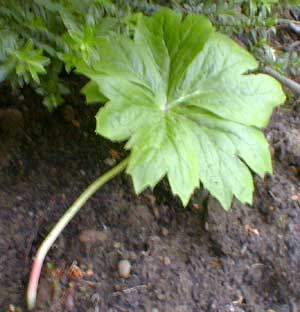
North American Mayapple
"I picked a tall Mayapple, like a fairy's parasol,
to be clowned with, by Father, later in the day!"
-Edna May Hermann
1996
1996
In its first year in our garden, our North American Mayapple (Podophyllum peltatum) isn't very impressive. It is shown in the April (2004) photo when it consisted of only the one plate-sized leaf. From this humble beginning we can expect a thick-rooted spreading clump that will take a few years to become amazing.
The rhizomes of this native of Eastern & Southwestern forests can spread underground for several feet & slowly over time colonize a moist shady area. It eventually forms a splendid groundcover that will be too aggressive to make a good companion with trilliums, dogtooth lilies, or jack-in-the-pulpits.
While waiting for it to start colonizing, one must in the meantime be careful not to plant around it things that in the future will be entirely overwhelmed by the mayapple's dense root system. This one is beside a largish Boxleaf Hebe which will always hold its own. There are also some small clumping biennials nearby which will not live long enough to be troubled by the spreading mayapple, but make nice filler while waiting for the mayapple to matures into a patch.
Dwayne at the famed Heronswood Nursery where we obtained this mayapple told us he planted one for himself in poor dry soil beyond the reach of easy irrigation, the conditions overall being nowhere near its preferences. Even so, it had done very well & had spread a great deal. His opinion was that the better you treat them, the more fiercely they will spread, but if you want to limit their tendency to colonize, mistreatment restrains them without harming the appearance.
The leaves when bruised or the roots if dug up emit a skunky odor. Even the flowers must be attempting to attract dung-loving pollinators. Fortunately you have to get on your belly & wack the plant to smell it; the odor is inoffensive in the garden.
This spring wildflower bears a single white bloom on a drooping stem, held underneath three large leaves that together form a foot-high umbrella. The flowers are usually at their height in May, though they can vary anywhere from April to June. Each plant's single bloom drops its petals almost as soon as it is pollinated, & sets a green fruit that ripens to yellow by August. We also have longer established in another garden the Himalayan Mayapple with very similar behavior, more deeply cut leaves, & a red rather than yellow apple.
Considering the short stature of the plant, the fruit is quite large, the size of the biggest cherry, or a small plum, hence the common name, though it more accurately resembles a pale yellow tomato rather than an apple.
Given the cruddy odor & toxicity of the plant overall, the "apples" have a wonderful odor, & are perfectly edible, despite a laxative effect if too many are eaten.
Since it is the flowers rather than the "apple" that appear in May, it has alternate folk-names that don't lead to the confusion of when it bears apples. It is called Indian Apple, Hog Apple, Racoon's Berry, & Wild Lemon. It has also been called Duck's Foot because presumedly the individual leaves within the circle of three resemble the webbed feet of ducks, & the genus name means foot-leaf.
It is elsetimes called Umbrella Plant which likewise alludes to its leaf appearance. Another name for it is Wild Jalap, due to the cathartic & purgative medicinal qualities similar to jalap (Ipomoea jalapa). But the most common name after Mayapple is American Mandrake because of the extensive thick rhizomes that resemble the mandrake (Mandragara officinalis). It has frequently been dug by mandrake hunters & used for all the same purposes as mandrake, despite that it is sufficiently poisonous to cause death when injested.
As a medicinal plant, an extract of the root, podophyllin resin, was a standard household emetic in the 1800s & ealry 1900s. It was formerly the active ingredient of Carter's Little Liver Pills. It has been extensively studied for sundry medicinal uses, but the specific information that surfaced from clinical trials was not as promising as the folklore would have it. The plant's toxicity for internal use, numerous side-effects up to & including paralysis, coma, or death; its interactions with prescription drugs; & its dangerousness to pregnant women, all contributed to the dwindling of its popularity as an herbal remedy.
Though no longer recommendable for internal use, mayapple extract continues to be used topically for papilomavirus-caused venerial warts. Even as a topical treatment the side-effects may outweight the benefits. It can itself cause skin ulcerations, system toxicity from absorption through skin, Since podophyllin has no effect on the papilomavirus per se, & because most veneral warts vanish & recur at intervals with or without treatment, the usefulness of podophyllin is debated.